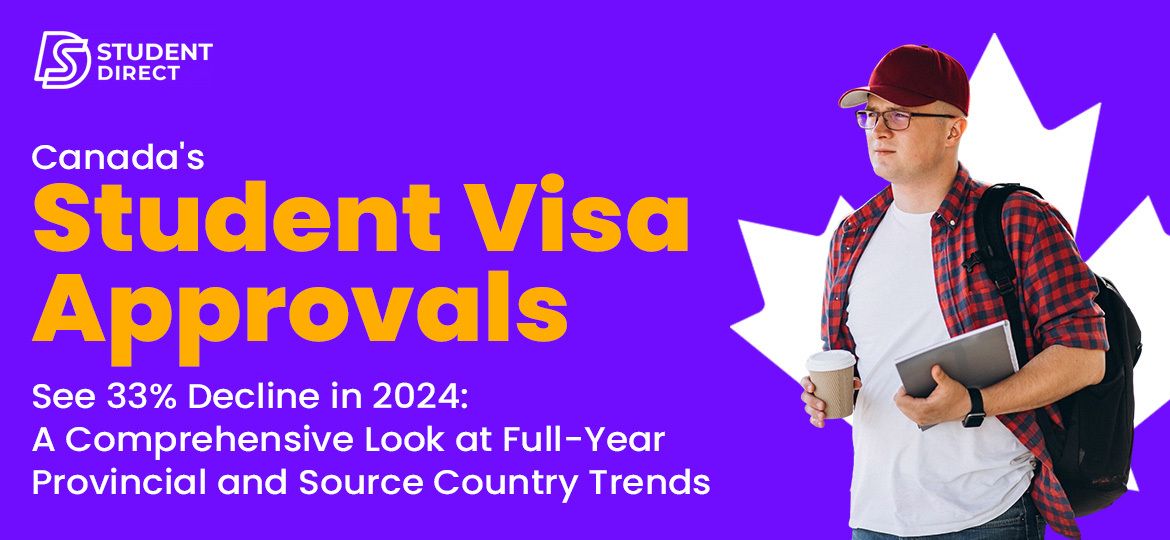
Welcome to the latest edition of our Data Dive series, where we analyze the seismic shifts in Canada’s international student visa landscape. This time, we’re diving into the full-year data for 2024, sourced from a custom dataset provided by Immigration, Refugees and Citizenship Canada (IRCC). The numbers paint a stark picture: Canada’s student visa approvals experienced a dramatic decline, with far-reaching implications for provinces, source countries, and the broader education sector (and honestly our Country).

In 2024, according to IRCC, Canada issued 394,430 student visas, a significant drop from 600,625 in 2023—a 34% decline. Alongside this, the global approval rate slipped from 65% in 2023 to 60% in 2024. This downturn, exceeding initial government projections, signals a challenging new reality for Canada’s international education sector—one that’s likely to persist into 2025. It’s key to remember that the changes to PGWP eligibility didn’t fully take effect till the end of 2024. We are likely to see significant pain going into 2025.
Colleges have seen a far more dramatic decline than Universities. Visa approval challenges have deepened, especially for emerging markets, which does not augur well for the overall diversity of our student population.

Observations for Major Source Countries
- India: Despite remaining Canada’s top source country, India saw a steep 40% decline in approvals, dropping from 269,530 in 2023 to 162,100 in 2024. Interestingly, approval rates for Indian applicants improved, rising from 77% to 86%, reflecting resilience in this key market.
- China: China stabilised in 2024, with approvals declining by just 10%, from 41,845 to 37,480. Approval rates remained robust around 90%, underscoring Canada’s enduring appeal. This stability is likely based on the country’s preference for universities.
- Nigeria: The third-largest market nearly halved, with approvals falling 44% from 33,085 in 2023 to 18,640 in 2024. Approval rates dropped, from 38% to 33%.
- France: Approvals declined by 8%, from 15,245 to 13,970, with approval rates holding steady around 95%.
- Philippines: Approvals fell 50%, dropping from 21,775 to 10,860, with approval rates decreasing from 66% to 59%.
- Iran: Approvals dropped 31%, from 12,640 to 8,660, with approval rates falling from 68% to 53%.
- Nepal: Approvals declined 56%, from 17,485 to 7,615, with approval rates dropping from 64% to 37%. Nepal has dropped out of the top 5 source markets for Canada and will likely continue to fall.
- Algeria: Approvals fell 34%, from 10,915 to 7,230, with approval rates decreasing from 40% to 27%.
- Ghana: Approvals saw a better-than-expected 19% decline, from 8,390 to 6,785, with approval rates dropping from 46% to 24%. This is the most significant movement within the emerging markets, as even with a fall in approval rates, the overall numbers have fallen less than the global average. This underlines the tremendous interest in Canada from the market.
- Vietnam: Approvals decreased by 6%, from 7,210 to 6,775, with approval rates increasing from 79% to 81%.
- French-Speaking Countries: Nations like Senegal and Guinea bucked the trend, with Senegal seeing a 21% increase (from 4,435 to 5,360) and Guinea, Republic of, growing by 4% (from 4,270 to 4,455). Other Francophone countries, such as Ivory Coast, saw declines, but less severe than the national average, with an 11% drop (from 4,905 to 4,385).
- Struggling Markets: Nepal, Iran, the Philippines, and Colombia faced steeper-than-average declines, with Colombia seeing a 43% drop (from 8,235 to 4,685) and Pakistan a 20% decline (from 4,180 to 3,360).

Provincial Breakdown
The provincial data reveals significant variations in both approval numbers and rates:
- Ontario: Approvals fell sharply from 313,325 in 2023 to 183,840 in 2024, a more than 40% decline. Approval rates dropped from 69% to 68%.
- British Columbia: Approvals decreased from 96,275 to 63,655, a 33.9% decline, with approval rates slipping from 76% to 74%.
- Quebec: Approvals dropped from 64,715 to 53,920, a 16.7% decline, with a notable approval rate plunge from 48% to 37%.
- Alberta: Approvals fell from 30,925 to 22,090, a 28.6% decline, with rates dropping from 74% to 69%.
- Manitoba: Approvals declined from 15,480 to 9,625, a 37.8% decline, with rates falling from 60% to 58%.
- New Brunswick: Approvals dropped from 7,630 to 4,285, a 43.8% decline, with rates increasing marginally from 44% to 45%.
- Nova Scotia: Approvals fell from 10,185 to 6,050, a 40.6% decline, with rates increasing significantly from 45% to 51%.
- Prince Edward Island: Approvals plummeted from 1,960 to 990, a 49.5% decline, with rates crashing from 66% to 54%.
- Saskatchewan: Approvals declined from 8,695 to 5,720, a 34.2% decline, with rates falling from 55% to 46%.
- Newfoundland and Labrador: Approvals dropped from 3,015 to 1,920, a 36.3% decline, with rates decreasing from 62% to 53%.
Final Thoughts
The 2024 data reveals a significant downturn, driven by policy uncertainty and shifting global demand. While the declines are steep, institutions have an opportunity to pivot their strategies, focusing on program realignment, direct engagement with resilient markets, trust-building with students, and market diversification. The path forward requires resilience, creativity, and a commitment to adapt to this new normal. The challenges are significant, but so too are the opportunities to reshape the narrative and rebuild for the future.
Up Next!
In the coming weeks, we will take a look at DLIs with the highest visa approval numbers and approval rates, along with some data focused on major and emerging markets. Stay tuned!

